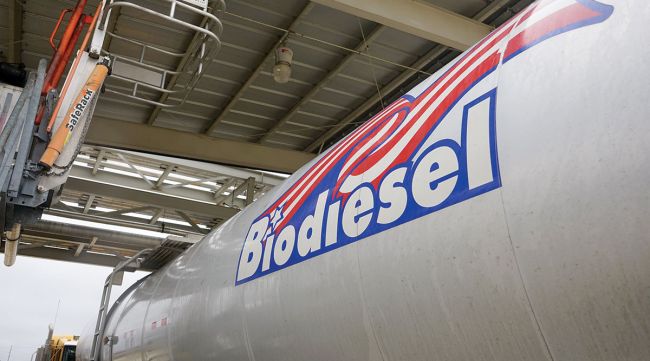U.S. biofuel production is burgeoning in the race to meet federal and state government mandates to lower heavy truck emissions.
First-ever biofuel achievements have been recorded in recent months. The U.S. Energy Information Administration revealed Sept. 5 that for the first time, production capacity for renewable diesel and other biofuels in January reached 3 billion gallons per year, outpacing biodiesel’s capacity of 2.1 billion gallons.
California state officials in August proclaimed a milestone in replacing 50% of diesel used there with clean fuels.
“As technological advances put a zero-emissions future within reach, the use of cleaner fuels offers an essential tool to reduce pollution now,” noted Steven Cliff, executive officer at the California Air Resources Board.

Cliff
Both renewable diesel and biodiesel can be used to replace diesel. Able to be used in diesel engines in any concentration, renewable diesel is chemically identical to petroleum-based diesel but made with fats, vegetable oils or greases. Similarly, biodiesel is made with the same feedstocks but blended with diesel and is chemically different.
“Nationwide, overall biofuels production capacity — which includes renewable diesel, biodiesel, ethanol and other biofuels — reached 23 billion gallons per year in January 2023, a 6% increase in total production capacity from January 2022,” EIA noted.
Ethanol has the largest share of production capacity (78%), followed by renewable diesel/other biofuels (13%) and biodiesel (9%).
With California consuming nearly all the renewable diesel made nationally, U.S. production capacity for renewable diesel/other biofuels increased in January by 1.25 billion gallons per year (soaring 71% increase from 2022).

Transport Topics’ Seth Clevenger, Michael Freeze and Mike Senatore dissect the new Top 100 list of the largest private carriers, including how fleets are adapting to this softened market. Tune in above or by going to RoadSigns.ttnews.com.
The top renewable-diesel-producing states are Louisiana, Texas, California, Wyoming, North Dakota, Montana, New Mexico, Oklahoma, Washington, Kansas and Mississippi. EIA noted that more states are getting into the renewable diesel business, such as Texas, “which had no renewable diesel and other biofuels capacity in January 2022. By January 2023, Texas had 537 million gallons/year of capacity, the second highest after Louisiana.”
More than 60% of U.S. renewable diesel is made along the Gulf Coast. However, ethanol and biodiesel are mostly made in the Midwest. Over 70% of U.S biodiesel capacity comes from Iowa, Missouri, Illinois and Indiana.
“Rising targets for state and federal renewable fuel programs and the renewal of biomass-based diesel tax credits are driving this growth in U.S. renewable diesel capacity,” EIA stated. The Internal Revenue Service has extended through Dec. 31, 2024, its biodiesel income tax credit of $1 per gallon for on-road fuel use or delivery of biodiesel, agri-biodiesel or renewable diesel.
Despite the federal tax incentive, biofuel producers took issue with the U.S. Environmental Protection Agency’s recent allocations for Renewable Fuel Standards for biofuel output, which many producers contend underscores current and future production growth.

Kimberley
Grant Kimberley, executive director of the Iowa Biodiesel Board, told Transport Topics, “We are frustrated with the small amount of biodiesel that oil refiners will be required to blend into their petroleum diesel products nationally. In the final rule, EPA increases RFS volumes for biodiesel and renewable diesel by only 60 million gallons in 2023, 220 million gallons in 2024 and 310 million gallons in 2025.”
Kimberley, also the Iowa Soybean Association’s senior director of market development, is concerned that the lower biofuel standards is sending “mixed signals to our biodiesel producers, domestic [soybean] crush industry and the farm economy” by decreasing future biofuel investments. Soybean crushing is important for processing beans by separating the oil from the meal. “For the most part, the meal goes into the food supply, and a percentage of the leftover oil goes into biodiesel production,” added Kimberley.
“Biodiesel is a part of this wave like never before,” noted Brad Wilson, president and general manager at both Western Iowa Energy and Agron Bioenergy, which owns a biodiesel terminal facility in California. “Biodiesel producers continue to excel. We are investing in our Iowa plant to keep Western Iowa Energy at the forefront of biodiesel production. Our upgrades will allow us to always have the ability to use soybean oil for biodiesel but also use other low-carbon feedstocks like animal fats, distiller’s corn oil and used cooking oil.”

Western Iowa Energy plant, Wall Lake, Iowa. (Iowa Biodiesel Board via Flickr)
Wilson encourages the trucking industry to turn to biodiesel blends to help bring about positive changes.
“Biodiesel burns cleaner, which is better for the environment and our health while contributing to the farm economy, U.S. jobs and increasing domestic energy security,” he said. “The most important thing for truckers to know about biodiesel is that if you heard anything negative about it 20 years ago, forget it. Specification changes and attention to fuel quality have significantly improved biodiesel in North America. Your cellphone of 20 years ago doesn’t compare with your phone today, and the same is true for biodiesel.”






